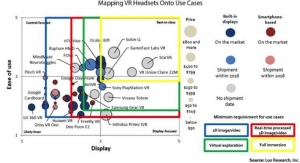Tony Sun and Anthony Schiavo, Lux Research09.07.16
Researchers from Harvard University, in collaboration with Massachusetts Institute of Technology (MIT) and Samsung, developed a material screening software, Molecular Space Shuttle (MSS), to identify high-performance molecules as blue thermally activated delayed fluorescence (TADF) emitters for organic light-emitting diodes (OLED).
By incorporating theoretical chemistry, machine learning, and cheminformatics, MSS identified thousands of potential candidates from a total of 1.6 million molecules. Some of the candidates with highest potentials are experimentally verified to demonstrate external quantum efficiencies (EQE) as high as 22%. In comparison, Cynora, a blue TADF emitter developer, reports EQE ranging between 10% to 18%, depending on the emitting wavelengths, and the record EQE in academia is about 20%.
The team demonstrated a process to not only screen for the top OLED candidates, but also to optimize the workflow between theorists and experimentalist over the four steps summarized below.
1. Theorist generation of a candidate pool. The team used an in-house quantum chemical calculation software to generate molecules by combinatorial enumeration, which is based on an open source cheminformatics software RDKit. To prevent chemically unstable patterns, a blacklist of disallowed structures was compiled by experimentalists. The result of this step is pool of 1.6 million molecules.
2. Identification of high-potential candidates. The team started with simulating the properties of a set of randomly picked molecules, and used the simulated results to train the machine-learning algorithm. The machine learning algorithm was then used to predict which molecules were likely to have good properties. The highest ranked one was promoted to a detailed simulation. The result of this step is about 4,400 candidates with promising simulated properties.
3. Selection of candidates for experiment validation. A group of two to six experimentalists were then asked to rate the high potential candidates by their predicted properties, novelty and synthetic accessibility. To make this process efficient, the team developed a web voting tool so that the experimentalist from different research groups can rate the candidates on a positive/neutral/negative scale. The result of this step is tens of molecules selected for synthesis.
4. Experimental validation. Selected candidates from the process described above were then synthesized and tested in devices. The theoretical predictions agree with experiments within the known accuracy of simulation and the noise in experimental measurements. The result of this step is the finding of molecules with leading properties.
Demonstration of an industry EQE record is no doubt a big academic achievement, yet improving EQE alone is not enough as improved lifetime of blue emitters is also required. MSS has demonstrated to be a powerful tool to calculate and predict the color and the brightness of molecules but has not shown any indicator of better performance in identifying longer lifetime.
TADF OLED’s major advantage over conventional phosphorescent OLED (PHOLED) is theoretically higher efficiency and potentially cheaper cost. Yet, blue TADF OLED can only last a few thousand hours before falling to 50% of original brightness (LT50), one order of magnitude shorter than the 20,000 hours of blue PHOLED, which is already orders of magnitude shorter than green PHOLED’s 1.5 million hours and red PHOLED’s 600,000 hours.
However, this approach also demonstrates an important linkage between the theorists and experimentalists, as much of the experimental expertise is difficult to identify, as often experimental expertise is antidotal. By using web voting, the experimentalists are able to screen for the candidates that they can actually make effectively, thereby speeding up the slowest part of the material discovery process. Particularly with electronic materials, where not all properties can be accurately calculated ahead of time, rapid material screening and synthesis is critical. Clients should look at how to apply methods like this to their electronic materials processes, even beyond OLED.
Tony Sun, Ph.D., leads the Electronic User Inter Intelligence team at Lux Research and Anthony Schiavo is an analyst on the Advanced Materials Intelligence team. Lux Research provides strategic advice and on-going intelligence for emerging technologies.
By incorporating theoretical chemistry, machine learning, and cheminformatics, MSS identified thousands of potential candidates from a total of 1.6 million molecules. Some of the candidates with highest potentials are experimentally verified to demonstrate external quantum efficiencies (EQE) as high as 22%. In comparison, Cynora, a blue TADF emitter developer, reports EQE ranging between 10% to 18%, depending on the emitting wavelengths, and the record EQE in academia is about 20%.
The team demonstrated a process to not only screen for the top OLED candidates, but also to optimize the workflow between theorists and experimentalist over the four steps summarized below.
1. Theorist generation of a candidate pool. The team used an in-house quantum chemical calculation software to generate molecules by combinatorial enumeration, which is based on an open source cheminformatics software RDKit. To prevent chemically unstable patterns, a blacklist of disallowed structures was compiled by experimentalists. The result of this step is pool of 1.6 million molecules.
2. Identification of high-potential candidates. The team started with simulating the properties of a set of randomly picked molecules, and used the simulated results to train the machine-learning algorithm. The machine learning algorithm was then used to predict which molecules were likely to have good properties. The highest ranked one was promoted to a detailed simulation. The result of this step is about 4,400 candidates with promising simulated properties.
3. Selection of candidates for experiment validation. A group of two to six experimentalists were then asked to rate the high potential candidates by their predicted properties, novelty and synthetic accessibility. To make this process efficient, the team developed a web voting tool so that the experimentalist from different research groups can rate the candidates on a positive/neutral/negative scale. The result of this step is tens of molecules selected for synthesis.
4. Experimental validation. Selected candidates from the process described above were then synthesized and tested in devices. The theoretical predictions agree with experiments within the known accuracy of simulation and the noise in experimental measurements. The result of this step is the finding of molecules with leading properties.
Demonstration of an industry EQE record is no doubt a big academic achievement, yet improving EQE alone is not enough as improved lifetime of blue emitters is also required. MSS has demonstrated to be a powerful tool to calculate and predict the color and the brightness of molecules but has not shown any indicator of better performance in identifying longer lifetime.
TADF OLED’s major advantage over conventional phosphorescent OLED (PHOLED) is theoretically higher efficiency and potentially cheaper cost. Yet, blue TADF OLED can only last a few thousand hours before falling to 50% of original brightness (LT50), one order of magnitude shorter than the 20,000 hours of blue PHOLED, which is already orders of magnitude shorter than green PHOLED’s 1.5 million hours and red PHOLED’s 600,000 hours.
However, this approach also demonstrates an important linkage between the theorists and experimentalists, as much of the experimental expertise is difficult to identify, as often experimental expertise is antidotal. By using web voting, the experimentalists are able to screen for the candidates that they can actually make effectively, thereby speeding up the slowest part of the material discovery process. Particularly with electronic materials, where not all properties can be accurately calculated ahead of time, rapid material screening and synthesis is critical. Clients should look at how to apply methods like this to their electronic materials processes, even beyond OLED.
Tony Sun, Ph.D., leads the Electronic User Inter Intelligence team at Lux Research and Anthony Schiavo is an analyst on the Advanced Materials Intelligence team. Lux Research provides strategic advice and on-going intelligence for emerging technologies.


















